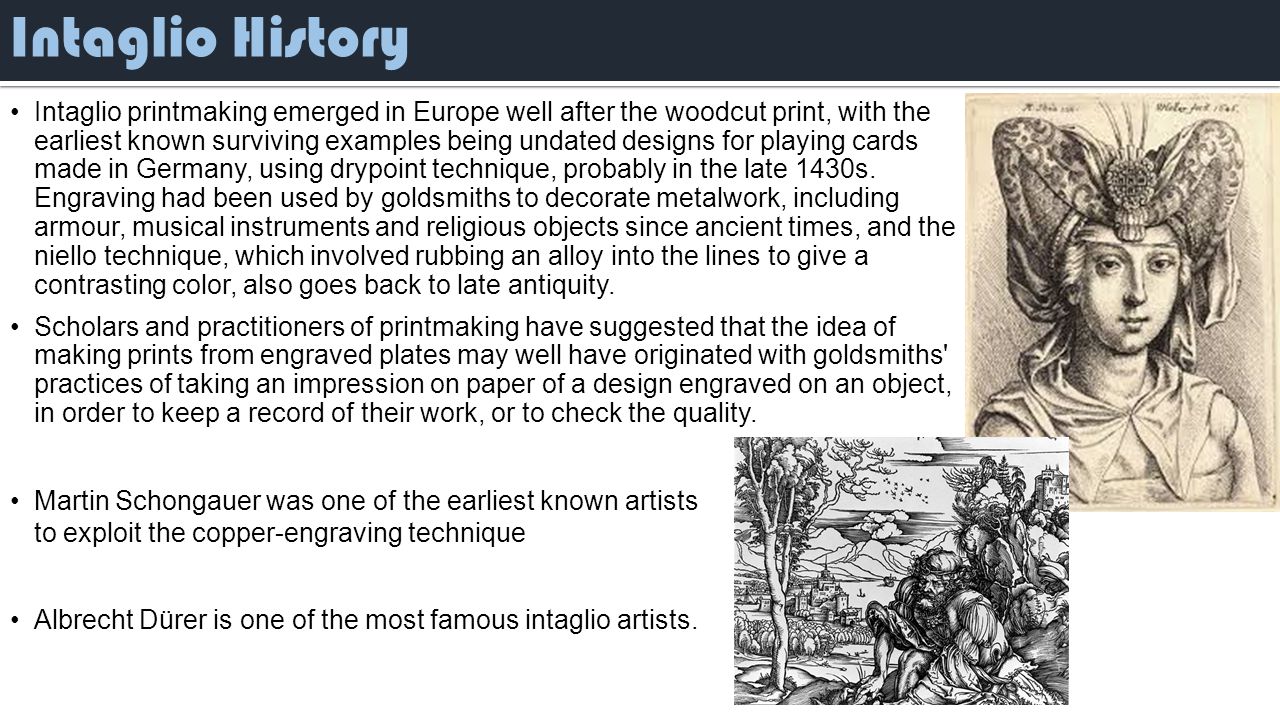

The acid eats into the metal where the wax has been removed, thus creating a design in the metal plate. Being careful as to not remove too much wax to avoid acid bleeding over the plate, the artist then creates an image in the wax, before submerging the plate into a bowl of nitric acid. Inspired by techniques used in the armourer’s trade, a metal plate is covered in a thin layer of acid-resistant wax, called the “ground”.
#INTAGLIO EXAMPLES SERIES#
Hendrick Goltzius, Polyhymnia, Plate 8 from series ‘The Nine Muses,’ (1592), engraving.Ī key difference between the process of engraving and etching is the use of acid. While he moved towards painting later in his career, Goltzius remains one of the most significant engravers of the 16th century. Polyhymnia, Plate 8 of ‘The Nine Muses’, is an example of how Goltzius’ moved towards more classical proportions and subject matter, while maintaining great depth and movement in his engravings due to his extravagant use of the swelling and tapering line. However, after a visit to Italy in 1590, he was left inspired by the classical statues, and this is reflected in his later work. Goltzius’ The Venetian Ball (1584) demonstrates Mannerism’s shift away from biologically realistic proportions, with densely robed and rotund bodies topped with tiny heads. Hendrick Goltzius, The Venetian Ball, (1584), engraving. van Haarlem, The Dragon Devouring the Companions of Cadmus, 1588, engraving. Hendrick Goltzius after Cornelis Cornelisz. Goltzius’ signature swelling and tapering line adds movement and an ostentatiousness to the rippling muscles of the men and the beast. In The Dragon Devouring the Companions of Cadmus (1588), blood spills from the muscular bodies of naked men, surrounded by the bones and heads of their fallen companions, as they are mauled by a whiskered dragon. Associated with the Northern Mannerism movement, and its vision for drama and exaggeration in contrast to the mathematical perfection preferred during the High Renaissance, Goltzius’ earlier work displays an almost hedonistic level of flair. His engravings became known for their virtuosic, swelling lines, creating remarkable shape and curve. Hendrick Goltzius (1558-1617), hailed from the Lower Rhine region of Germany. The resulting image is a reversed copy of that on the original plate. Once finished, ink is then smoothed over the carved metal plate with all excess ink removed, the plate and a sheet of dampened paper are passed through a printing press roller, thus forcing the ink held in the incising onto the paper. A thin layer of wax can be pressed on to the metal plate, onto which the artist can trace the lines of their drawings, thus providing a guide for their carving. While an engraver can freehand onto the metal, due to the complexity of most engravings it is common to begin with a drawing. The basic process of engraving involves a burin, a small bevelled diamond-shaped metal tool to carve lines into a piece of metal, usually copper or zinc. In Adam and Eve (1504), the great Albrecht Dürer (1471-1528) achieved a mindboggling density of fine lines, his work a stunning blend of form, shading, and texture. 1480-1534) successfully transposed the painter Raphael’s The Judgment of Paris (1510-20) into an engraving through his complex hatching system, creating smooth, round tones throughout the image. 1494-1533) achieved dimensional depth in his engravings by putting less pressure on the burin while carving the background. As the method engraving progressed throughout the 16th and 17th century, artists added their own innovations and developed their own unique styles.

In Italy, Florentine goldsmiths filled incisions in niello plaques of silver or gold with a dark substance to shade a design, thus serving as a precursor to engraving. The German Martin Schongauer (c.1450-1491) was the son of a goldsmith, and his work in the 1470s such as The Death of the Virgin laid the foundations for engraving as an art form. The art of engraving appears to have originated from goldsmithing techniques. Marcantonio Raimondi, after Rapael, The Judgement of Paris, (1510-20), engraving. While deceptively alike to the untrained eye, both in name and look, these two methods developed from different processes, were mastered by differing artists, and create dissimilar effects on the finished print. Studying the art of printmaking, it is necessary to grasp the difference between engraving and etching, two techniques of intaglio printing. This term encompasses a variety of print-making methods in which an image is created as incised sunken lines on a printing plate, rather than as raised ones. Intaglio printing is the opposite of relief printing.


 0 kommentar(er)
0 kommentar(er)
